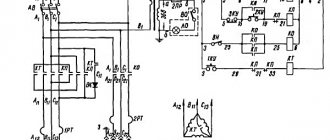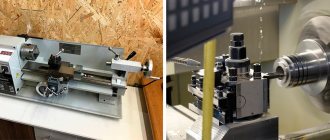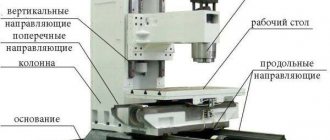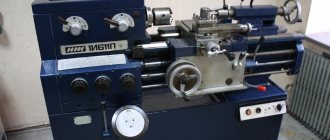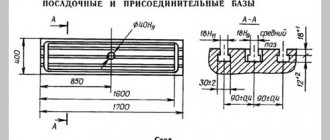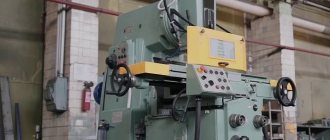What is it for?
The multi-purpose milling machine is designed for use in industrial enterprises. To process the surface with a horizontal spindle, the following cutters are used:
- disk;
- cylindrical;
- shaped.
When working with a rotary spindle, face and key cutters are used.
Model 675 includes the following tables:
- rotary with dividing head;
- inclined.
Using heads: cutting, high-speed slotting, boring, you can perform the following work on the machine:
- drill;
- countersinking;
- boring;
- Slotting.
The 675 machine produces bars, housings, cushions, levers, helical gears, and parts with complex configurations. Class H processing accuracy. The ability to install a horizontal rotary head on a vertical spindle makes the machine universal. It can be used to process all sides and the top surface of a part, drill it along all planes and at an angle, and make boring with high precision.
Advantages and disadvantages of the model
The 675 milling cutter under consideration is characterized by quite a large number of advantages. They are as follows:
- The frame is thick and made of cast iron. This ensures high strength and rigidity. Vibration damping leads to high precision milling.
- The device in question can be used for processing both large and small products.
- In most cases, milling equipment is used to work on an individual project. In addition, there is a model for small-scale production.
- The controls are very simple and intuitive.
- The design is characterized by relatively small dimensions. In addition, the low weight of the milling machine allows them to be installed in home workshops.
- The device has a wide rotation range, which allows you to choose the most suitable operating mode.
- There is an electric pump that supplies coolant to the milling site. Such a lubricant significantly reduces the temperature in the cutting zone.
- The device has a spindle head that rotates 90 degrees in two directions.
The disadvantages of this model are also significant. An example is the relatively low reliability, as well as a reduced performance indicator, due to which the model cannot be installed for the production of large series of products.
General view and controls
The base is tall with an electric box on the side and an electric motor at the rear. Feed box inside a thick-walled cast rack. The gearbox is assembled in a separate box and located on the side. A small console rises along guides, ensuring vertical movement of the part.
The main table with T-slots is equipped with additional accessories, including a removable horizontal table. On the right side of the stand and table there are handwheels for manual movement of the table and console. There are also start buttons and a handle for switching spindle rotation speeds.
Design Features
The 675 milling machine is characterized by its small size and the ability to process workpieces up to 600 mm long. The design includes two spindles, a working vertical table and a removable horizontal one. The machine kit includes a cabinet for accessories and tools.
Main movement chain
Rotation is transmitted to the horizontal spindle through gearing with a drum gear connected to the gearbox. The electric motor is connected to the drive shaft by a V-belt transmission. The vertical spindle rotates through a bevel gear connection with a horizontal motor. The speed of both working bodies is adjusted using one handle.
Feed chain
The feed chain transmits movement to 3 working units at once, ensuring movement along all axes:
- support – vertical;
- slide – longitudinal;
- spindle head – transverse.
The rapid stroke is 935 mm/min. 16 working feeds, from 12.5 mm/min to 400 mm/min. The feed mechanism operates from the main drive, receiving rotation from the gearbox through the toothing of the gears.
Caliper
Through the support, longitudinal and transverse movement of the table with the part is carried out through the lead screw and the drive shaft. The direction of movement in 3 directions is activated by one cross handle in the direction of movement. The parts are lubricated with a lubricator.
bed
The bed has a high base. On top there is a trunk used when working a horizontal spindle with cylindrical cutters. On the side of the frame body there is a box molded for the feed box. It closes with a door. In the front part there is a rack with console guides.
Horizontal spindle
The horizontal spindle is located in the upper part of the frame, under the trunk. It receives rotation from the gearbox through gearing. The spindle head is mounted on 2 radial supports and rests on 4 thrust bearings. To fasten parts in the spindle there is a Morse taper 4. When installing a mandrel with cutters, use an earring.
The trunk is moved manually. Clamped in working position on the right with 2 handles. The rotation speed is adjustable in steps and has 16 positions. The movement of the spindle head in the horizontal axis is limited by stops. Mineral oil lubrication is carried out by splashing. The liquid is supplied to the sump of the spindle head housing.
Vertical spindle
The vertical head is a removable unit. It is secured to the horizontal spindle head with two screws and receives rotation from it. Installation is carried out according to risks for the alignment of rotating parts. The trunk is retracted to the rearmost position.
The vertical spindle together with the head is rotated 90⁰ manually according to a scale marked on the base of its body and secured with pins. A spring built into the body balances the sleeve as it moves. Radial loads are absorbed by two supports. Axial vibrations are damped by thrust bearings.
Description of individual components and accessories
When describing the composition of the Model 675 machines, the following working units can be distinguished.
Functional cantilever milling machine 6t80sh: description of the main components, characteristics
bed
This is the base of the machine on which all other working units are located. Controls for milling and drilling modes, as well as turning the device on and off are also located here.
Caliper
This unit ensures the supply of the workpiece through lead screws 1 and 8, as well as the main drive shaft 24. Its direction is changed using the cross handle (position 16).
In extreme positions in all planes of movement of the caliper, its supply is turned off due to special stops with limit switches 6 and 15.
Horizontal spindle
The horizontal position of the spindle is its main operating state, in which milling operations are carried out on parts fixed on an angular inclined table. It is mounted on the frame on the right and is controlled by a separate rotating feed handle.
Vertical spindle
The vertical head is a removable unit, when installed, the equipment can be easily adjusted to another operating mode. It is fixed to the headstock using two bolts coaxially with the second spindle. The head, placed vertically, can be rotated 90° on both sides, for which purpose there are markings on the body flange in the form of divisions in degrees.
Corner universal table
The plane of the horizontal universal table has a built-in tilt adjustment mechanism, which ensures the convenience of processing workpieces mounted on it.
Round table
The rotary round table is located in the center of the bed; it is needed to fix workpieces processed using a tool fixed in the spindle.
Parallel vice
Special parallel vices are used to clamp the workpiece in the main work table. Their presence significantly simplifies the fixation of workpieces before processing and increases the productivity of operations.
Dividing head
A special dividing or impact head is not included in the standard configuration of this piece of equipment. It is usually purchased separately and installed on a vertical spindle. It is used when it is necessary to cut various grooves and splines on metal workpieces or for sawing.
Corner universal table
The removable corner table is hung on the support using the upper dowels. Screwed to the work surface with bolts. It has 5 T-shaped slots for securing the workpiece and rotates it around a horizontal axis. The table rotates manually, along the dial on the front. The clamp handle of the device is also located there.
Reference! The corner table allows you to process the side planes of the part with both spindles. Do drilling and boring, keyways, mill polyhedra around the perimeter.
Vise
The vice is installed on the work table and rotary table. They allow processing small parts with high precision and making complex reliefs.
Round table
The removable accessories included with the machine include a round table. It is attached to the longitudinal table. Thanks to the dividing head, its functionality is increased. The side and top surfaces of the workpiece are processed using a horizontal spindle.
Dividing head
The dividing head allows you to rotate the part at a given angle with high accuracy. The device allows you to produce gears and other complex parts with repeating elements.
Specifications
The power of the machine is determined by its electric motor and is 1.5 kW. Accuracy class N and P according to GOST 8–82. Technical characteristics of the SF675 model:
- vertical table dimensions 200×500 mm;
- corner 200×630 mm;
- vertical stroke 300 mm;
- longitudinal movement 320 mm;
- transverse 300 mm;
- number of horizontal table feeds 16;
- number of spindle speeds 16;
- horizontal spindle rotation speed 50–1600 rpm;
- vertical 63–2000 rpm;
- machine dimensions 1110×1170×1650 mm;
- weight 1100 kg.
The vertical head can be rotated up to 90⁰. This allows processing of all planes except the base one. Do milling, drilling and boring, cutting threads, cutting grooves.
Electrical equipment of milling machine 675P
The main electrical equipment of the 675P router includes:
- Two electric motors (main – 1.7 kW and pumping station).
- A starter with a contactor that reliably starts the main motor into operation.
- A step-down transformer that provides the necessary power for the light bulb (36 Volts).
- Control elements for turning on and off both electric motors and auxiliary components.
In addition, its kit includes devices for protecting electrical circuits from overloads and short circuits (short circuit).
Passport of a universal machine
The passport begins with an indication of the brand of the machine and an indication of the manufacturer. Next, there is an image of the equipment in all projections, a description of the main components. All accessories and devices included in the equipment are listed with their functions. The document includes all diagrams, drawings of the main components and a list of wear parts. To transport the machine, the passport contains diagrams for slinging and installation on the foundation.
The passport of the milling machine can be downloaded for free from the link - Passport of the wide-universal milling machine SF 675.
Kinematic diagram
To understand the features of the interaction of individual components of the machine, it is advisable to study its kinematic diagram.
Description of the scheme
The specified document is usually given in the machine passport and is accompanied by a decoding of the designations of individual components and parts (photo on the left).
Only after familiarizing yourself with it can you proceed directly to mastering the basic techniques of working on the machine.
Main movement chain
From an engine with a declared power of 1.5 kW, torque is transmitted by a belt to shaft 1. From it, through the KS, it goes further to gear 54, and then through another gear 39 to spindle VI.
In turn, spindle VIII receives a drive impulse from its horizontal counterpart through a pair of bevel gears 40, 41 and a cylindrical pair of gears 45, 44.
Various positions of the KS block gears provide a wide range of speeds for both spindles.
Feed chain
The feed chain drives the vertical support, as well as the longitudinal slides located on the bed and the headstock located right there (in the latter case, the movement will be in the transverse direction). The speed range at 16 feed rates is from 12.5 to 400 mm/minute.
The feed mechanism is combined with the main transmission of the electric drive and receives rotation from the CV through gear elements 30, 29. When moving with acceleration, the coupling XIV located on the shaft comes into engagement with the wheel, position 71.
Features of modification 675P
The model of the wide-universal milling machine 675P is equipped with a tool cabinet. The machine has advantages over other units of the 675 series:
- increased processing accuracy;
- increased size of processed parts up to 250 mm in width and 800 mm in length;
- powerful pump with a supply of 22 liters of oil per minute;
- additional control panel on the side of the rack.
The small-sized machine can be installed in small workshops and garages.
Related Posts via Categories
- Shell end mill – high-quality cutting of steel and cast iron
- Do-it-yourself copy-milling machine - we create reliable equipment!
- Mini milling machine - how to assemble it yourself?
- Homemade metal milling machine - assembled without problems!
- Dividing head for milling unit and other devices
- Milling and engraving machine - a high-precision unit with program control
- Turning and milling machine – what gives us its versatility?
- Tabletop CNC milling machine – high-precision machining of small products
- Corvette 83 – reliable equipment for milling wood blanks
- NGF-110 (Sh4) – a reliable and efficient training milling unit
Reviews
Sova.
675 were produced by several factories. Odessa and Saratov residents did them best. These machines are distinguished by their reliability, high build quality and durability. They are in great demand among specialists and work well, despite their age. Vladimir. I use my 675 to cut axle shafts and torsion bars. I normalize the steel. It doesn’t catch hundreds, but it works up to tens. I want to change the rulers and clean up the guides so that I can work more accurately. Despite being over 50 years old, the 675 milling machines are well preserved and are in demand among specialists. They are almost half the price of their Chinese counterparts, they work better and are more reliable. They produce spare parts for repairs and parts for various components.
Purpose and scope
The main purpose of this class of equipment is semi-automatic processing of ingots from a wide variety of materials (cast iron, various types of steel and non-ferrous metals).
They can be equipped with a wide range of cutters for working on a horizontally oriented spindle from the following range:
- Cylindrical types of equipment;
- Disc tools.
- Shaping cutters, etc.
When processing workpieces, not only end or end tools are used, but also keyed equipment, fixed at an arbitrary angle to the horizontal.
